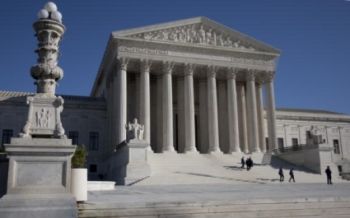
Publisher:
Bonnie King
CONTACT:
Newsroom@Salem-news.com
Advertising:
Adsales@Salem-news.com

~Truth~
~Justice~
~Peace~
TJP
Apr-15-2013 11:28

 TweetFollow @OregonNews
TweetFollow @OregonNews
Ohio Jurist Says US Supreme Court Should Allow Cameras
Maureen O'Connor, Chief Justice - Supreme Court of OhioOriginally published as an editorial in the Columbus Dispatch
 Special thanks to RTDNA |
(ALRON RTDNA) - As the U.S. Supreme Court heard historic oral arguments same-sex marriage last week, a debate outside the courtroom centered on a timeless question facing the top court in the land: Should the justices respond to public opinion or lag behind as society moves forward?
What we witnessed last week leads me to the inescapable conclusion that the U.S. Supreme Court should catch up with the nation. It is time for the court to allow cameras in its courtroom.
I write not as chief justice of the Supreme Court of Ohio but as a citizen. I have a unique perspective by virtue of my experience as a justice on a televised Supreme Court.
Regardless of one’s views on same-sex marriage, this week offered a spectacle of vivid images demonstrating that the justices are lost in the 19th century when it comes to being open and transparent to the public they serve. Rather than seeing lawyers in action before the justices, we saw citizens huddled in the cold for days, waiting for a ticket to have the privilege to watch our democratic system of justice in action. There are more than 300 million Americans, but only 500 seats in the Supreme Court gallery.
For most of us, after two days of arguments, we only have access to almost comical courtroom sketches of the proceedings rather than video or even still photographs. We are left with talking heads speculating on what they did not personally observe. These images serve no purpose but to further erode the public image of the court.
Late last year, public confidence in the Supreme Court reached its lowest point in 25 years. In one poll by The New York Times and CBS News, only 44 percent of Americans said they approved of the job of the court. About 75 percent said they believe the court’s decisions are influenced by politics.
In this Information Age — when you can post a video of your child’s piano recital, and his grandparents “like” it on Facebook before he has finished playing — the public’s expectations about how they acquire knowledge and understand the world have undergone a radical metamorphosis. The impact of video and audio has no equal, and absent really being there, there is no substitute.
The tired old arguments against allowing cameras in the courtroom are approaching flat-Earth status. They fall into one of four categories:
1. Justices, counsel or observers will grandstand for the cameras. Like many of our counterparts across the nation, the Ohio Supreme Court broadcasts its oral arguments live, in our case for almost 10 years. Initial speculation of grandstanding has proved unfounded. Our archived video, coupled with online access to briefs and opinions, represents a superior learning tool that has been utilized thousands upon thousands of times.
2. Allowing cameras detracts from the majesty and decorum of the proceedings. To the contrary, cartoonish courtroom sketches detract from the proceedings, and as already noted, the public today distrusts what it cannot observe. Technology has advanced to where the cameras are wall-mounted and unobtrusive. The presence of a camera operator is unnecessary, and there is no distraction.
3. Things will be taken out of context, and the general public won’t understand the nuance and complexity of the legal argumentation. This one is the worst because it is elitist and insulting to the public. The inevitable result of this attitude is that the public is forced to process its information about the court through the filter of the media because there is no direct option available. This is a democracy. We settled the question of whether we trust the people to govern themselves 230 years ago.
4. The justices are reluctant to become public figures. Justices are not “ivory-towered,” nor should they be. Justices write and promote their books; they lecture and often participate in teaching events and interviews. The American people are as entitled to know who sits on the Supreme Court as they are entitled to know their local council member or mayor. And they are entitled to see them in action.
The court is to be commended for allowing same-day audio recording of certain big arguments, and select federal lower courts have been experimenting with recorded video. However, the day will come when all U.S. Supreme Court cases are broadcast live in their entirety.
When it does, people will look back on this era the way we do today on the days when ladies were not allowed on the floor of Congress.
The times, they are a’changing. It’s time for the U.S. Supreme Court to catch up.
Maureen O’Connor is chief justice of the Ohio Supreme Court
First published by the Columbus Dispatch
Source: Radio Television Digital News Association
 |
 |
 |
Articles for April 14, 2013 | Articles for April 15, 2013 | Articles for April 16, 2013

googlec507860f6901db00.html
Salem-News.com:



Terms of Service | Privacy Policy
All comments and messages are approved by people and self promotional links or unacceptable comments are denied.
[Return to Top]
©2025 Salem-News.com. All opinions expressed in this article are those of the author and do not necessarily reflect those of Salem-News.com.